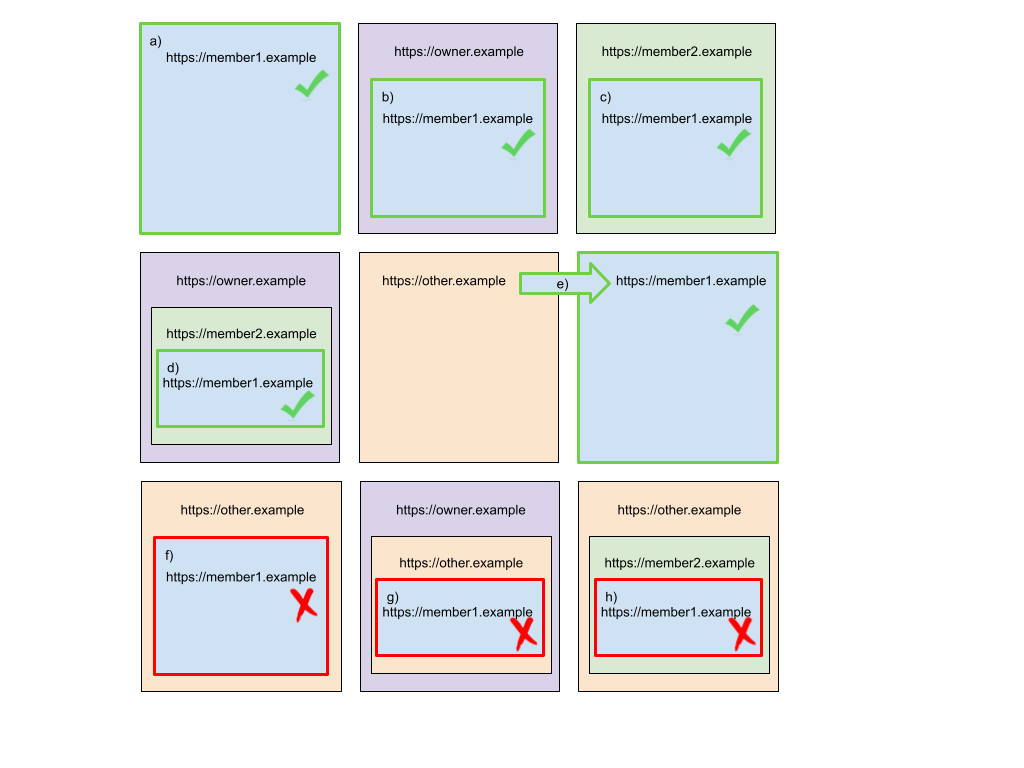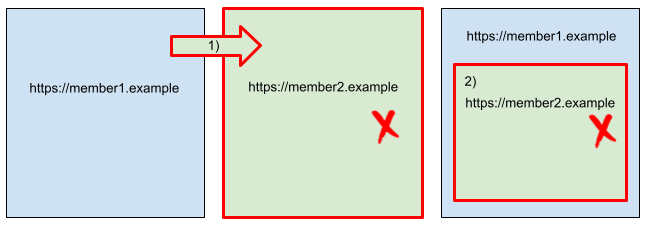This proposal has been archived, and further development has been stopped. Please see First-Party Sets issue #92 for more information.
In order to increase privacy on the web, browser vendors are either planning or already shipping restrictions on cross-site tracking, such as phasing out third-party cookies. Third-party cookies are currently defined as those associated with a site that is different from the site of the top-level page. However, modern websites are typically served over multiple domains/sites, many of which are owned by the same organization. For example, websites that host user-uploaded content often choose to host it on a different domain for enhanced security. First-Party Sets provides a mechanism to group domains/sites belonging to the same organization as being same-party with each other, and thus defines a privacy boundary for websites.
The SameParty cookie attribute provides web developers a means to annotate cookies that are allowed to be set or sent in same-party, cross-site contexts; and hence should not be subject to obsoletion. In addition, SameParty cookies are blocked in cross-party, cross-site contexts.
Introducing SameParty now, early in the process of phasing out third-party cookies, provides a means for sites to test out the First-Party Set behavior. While third-party cookies are still around today, we want to provide ample opportunities for web developers to test that their sites work with SameParty and to migrate their cookies to the new model far in advance of third-party cookies' obsoletion.
Allowing for both SameSite=Lax and SameSite=None lets developers decide the fallback behavior of a cookie if SameParty is not supported by a user’s browser. This helps smooth out the transition period before SameParty is widely supported.
A developer who is more interested in protecting a particular cookie’s content than having it sent may opt for SameSite=Lax; SameParty which will fallback to SameSite=Lax and protect the cookie from being sent from other sites.
On the other hand, a developer who is more interested in preserving the behavior of their site(s) which need a particular cookie may opt for SameSite=None; SameParty which will fallback to SameSite=None and allow for the cookie to continue to be sent.
First-Party Sets is intended to define a privacy boundary for websites, while continuing to treat site (and progressively, the origin) as the security boundary for cookies. SameSite=Strict provides CSRF protections in cross-site contexts that should not be loosened even when the sites in question are same-party.
Why introduce a new SameParty attribute? Why not treat SameSite=None as cross-site same-party cookies?
SameSite=None cookies without the SameParty attribute will be treated as cross-site cross-party cookies, which are on the path to obsoletion. In the long-term, browsers may choose to deprecate the SameSite=None attribute specification.
The SameParty cookie attribute can be applied to a cookie by appending it to the semicolon-delimited list of attributes in a Set-Cookie header, such as:
Set-Cookie: cookie=tasty; SameSite=Lax; Secure; SameParty
The SameParty attribute is specified without a value (as are Secure and HttpOnly). The Secure attribute is required in order to use the SameParty attribute. Any cookie specifying SameParty without Secure will be rejected as invalid. Additionally, any cookie specifying SameParty in the presence of SameSite=Strict will be rejected as invalid.
A browser that does not yet support the SameParty attribute should ignore the SameParty cookie attribute, but should not reject the cookie. However, Chrome installations where First-Party Sets are supported but have been disabled will still reject invalid SameParty cookies.
A cookie with SameParty may have SameSite=None or SameSite=Lax, or not specify a valid SameSite attribute. For such a cookie, any cookie access rules associated with the SameSite attribute will be ignored, and the SameParty rules (described below) will be enforced instead.
Table cells below give the effective enforcement mode for a cookie with a combination of the specified SameSite and/or SameParty attributes:
SameSite=None
|
SameSite=Lax
|
SameSite=Strict
|
Unspecified SameSite (treated as Lax)
|
|
Has SameParty
|
SameParty
|
SameParty
|
Cookie not valid, will be rejected | SameParty
|
No SameParty
|
SameSite=None
|
SameSite=Lax
|
SameSite=Strict
|
SameSite=Lax1
|
1 Cookies specifying neither SameSite nor SameParty attributes that are defaulted into SameSite=Lax mode will also be sent with non-idempotent (e.g. POST) top-level cross-site requests for a certain amount of time after their creation. Support for this temporary intervention (creation-time-based "Lax + POST") will be removed in the future.
A SameParty attribute overrides SameSite=None, such that browser interventions applying to SameSite=None cookies will not apply to cookies with a SameParty attribute (even if they also carry SameSite=None).
A SameParty cookie is included in an HTTP request if the origins of the requested URL and all of the ancestor frames in the target browsing context belong to the same First-Party Set. For example, a top-level navigation will always send SameParty cookies. Note that requests are treated the same regardless of the HTTP method (GET, POST, etc.), and the origin of the request initiator does not factor into whether the SameParty cookie should be allowed.
For example, suppose that owner.example owns a First-Party Set containing {member1.example, member2.example}. Then a SameParty cookie set by member1.example would be sent to https://member1.example in the following contexts:
- Main frame request
- Embedded in owner
- Embedded in different member of the same set
- Nested, ancestor frames all belong to same set
- Top-level navigation from unrelated site, regardless of HTTP method (GET, POST, etc.)
A SameParty cookie set by member1.example would not be sent to https://member1.example in the following contexts:
- Embedded in unrelated site
- Nested on owner site, but ancestor frames include unrelated site
- Nested on unrelated site, even if immediate parent frame is part of the same set
A SameParty cookie in a Set-Cookie response header is stored if and only if the corresponding request would have sent SameParty cookies in its request headers.
This means that the same rules (described above) apply to the contexts in which SameParty cookies may be set.
The SameParty attribute does not change cookies' behavior with respect to the Same Origin Policy; one domain is still prevented from reading or setting another domain's cookies. For example, a SameParty cookie set by member1.example would never be sent to https://member2.example, including in the following cases:
- Top-level navigation to another site, regardless of HTTP method, even if the site is a member/owner of the same set
- Embedding a different member/owner of the same set
SameParty cookies can be used with JavaScript APIs such as document.cookie and the CookieStore API. A SameParty cookie is accessible from JavaScript if the script is running in the context of a frame for which SameParty cookies were accessible when the frame was loaded.
Adding SameParty to a cookie that would otherwise be subject to the "Lax" or "Lax-allowing-unsafe" enforcement modes of SameSite weakens security properties by expanding the set of contexts in which the cookie may be accessed. A site that chooses to use SameParty cookies must accept the increased risk from CSRF and other cross-site attacks, and should have a commensurate level of trust in the other members of its First-Party Set. Ideally, other security measures should be in place, in particular, to protect against malicious cross-site top-level POST requests.
A site may use a SameParty attribute without being in a First-Party Set, in which case the same SameParty rules apply over a single registrable domain (i.e. the site's eTLD+1) rather than over a set of registrable domains contained in a First-Party Set. (Since, by default, a registrable domain that is not in any specified First-Party Set is treated as first-party with only itself.) Note that the SameParty access rules are equivalent to the Lax-allowing-unsafe enforcement mode of the SameSite attribute (a.k.a. "Lax+POST"), if the cookie's domain has a registrable domain not in a First-Party Set.
However, only for the initial prototype in Chrome, a cookie that specifies SameParty while the site is not in a First-Party Set will be subject to SameSite enforcement rules, rather than SameParty rules. This is because the First-Party Sets are to be delivered via Component Updater, and there may be a gap between when the First-Party Sets are updated and when the SameParty cookies are deployed, during which the cookies should not be subject to Lax-allowing-unsafe enforcement to avoid site breakage.
SameParty cookies are subject to the same user-controlled third-party cookie blocking settings as other cookies, during this initial prototype phase in Chrome. If a user has third-party cookie blocking enabled globally or for a specific site, cookies will not be sent in a cross-site context, regardless of the presence of SameParty. This behavior is intended for the initial prototype because we believe it aligns with users’ current expectations with respect to their privacy controls. For the eventual launch, we intend to treat members of the same First-Party Set as being within a first-party context (and thus not subject to third-party cookie blocking within that first-party context). However, we would like to make improvements upon this prototype in preparation for that launch. Specifically: (a) The UI surface to expose First-Party Set membership information to users is not part of this prototype; and (b) We hope to evolve UA Policy on acceptable sets during this period.

